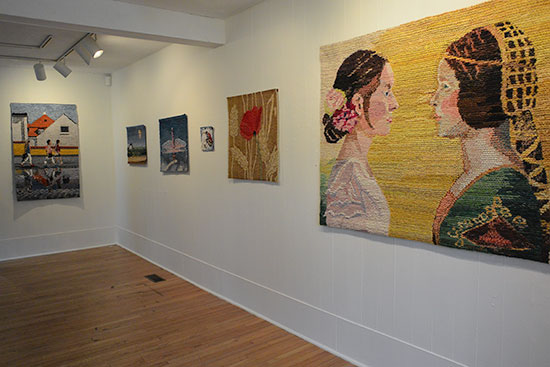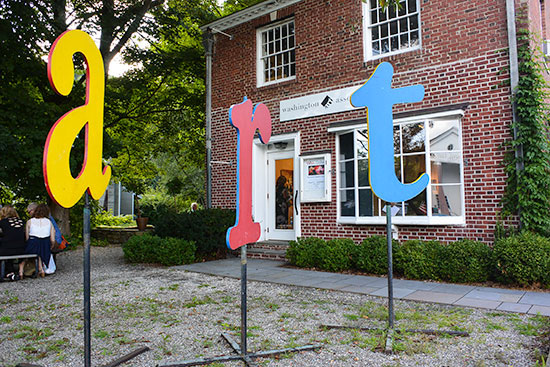
Helena Hernmarck talking about her work at the opening reception of The Nordic Tapestry Group: Weaving Knowledge into Personal Expression, photo by Tom Grotta
The Nordic Tapestry Group: Weaving Knowledge into Personal Expression opened on Saturday in Washington Depot, Connecticut at the Washington Art Association and Gallery, 4 Bryan Plaza and the Judy Black Memorial Park and Gardens at One Green Hill. The exhibition extends through September 9th. The Nordic Tapestry group was founded 10 years ago by weavers from Sweden, Iceland and the United States after tapestry artist Helena Hernmarck traveled to Sweden to teach workshops on her weaving technique. Combining traditional Swedish weaving techniques with her own method, Hernmarck is able to achieve powerful photorealistic effects by bundling a variety of hued yarns that combine to create an illusion of depth. With a common passion for textiles, members of the Nordic Tapestry group have a desire to learn more about how Hernmarck’s tapestries are made, how to use light and how to use the different qualities of yarn to create images. The exhibition highlights works by 21 of those students alongside Hernmarck’s works. Hernmarck’s Anemones (1985) dominates one of the exhibition galleries, attractively paired with the more recent and more translucent work, Amaryllis (2014). Holding their own in the large gallery are also Stone Bridge and the impressionistic Morning Haze, by Lis Korsgen, Hernmark’s very accomplished student.
In the Washington Art Association building are other works from Face to Face, which reveals the Nordic Tapestry weavers shared passion and ongoing exchange, and celebrates the transfer and evolution of weaving knowledge into personal expression. Through these works, they display their interest in using light and color and exploring the different qualities of yarn to weave images, create space and depth, and to depict three-dimensional forms. Swedish weaving has had a influential history in this country, in exhibitions, in creating art for the United Nations and in the curriculum at Cranbrook. For a very comprehensive look at this influence, including the role Swedish weaving has played in the work of American weaver Lia Cook, read Marion T. Marzolf’s paper, for the Textile Society of America, The Swedish Presence in 20th-Century American Weaving, http://digitalcommons.unl.edu/cgi/viewcontent.cgi?article=1313&context=tsaconf.


